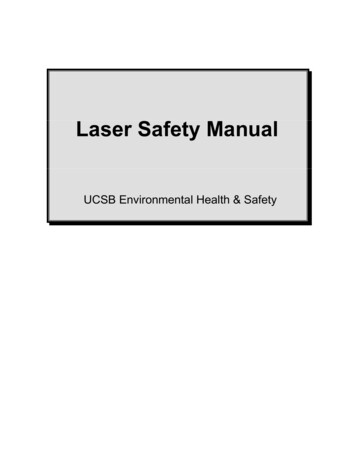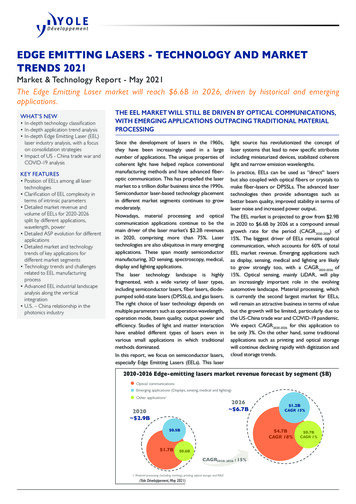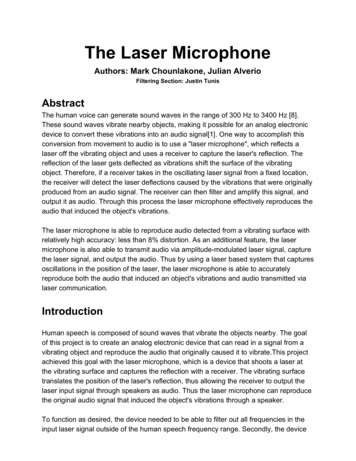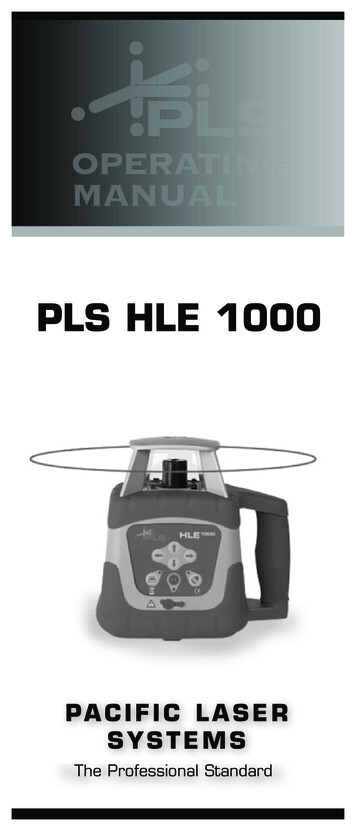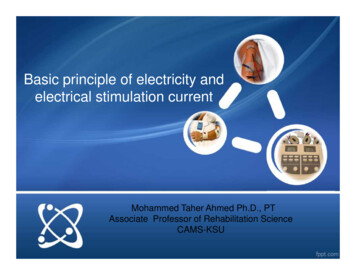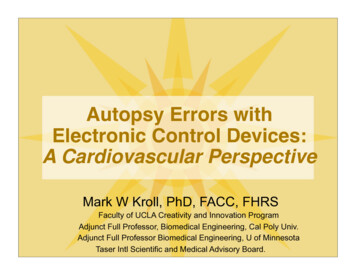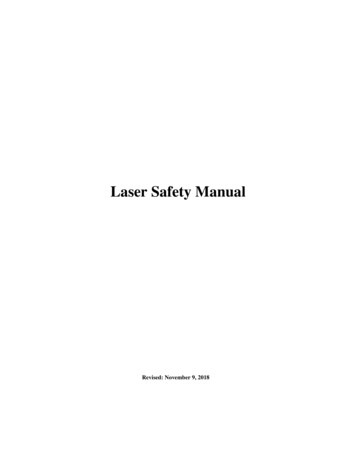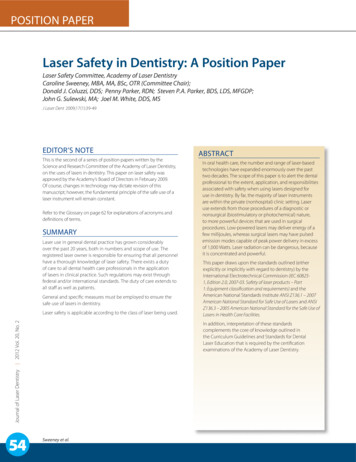
Transcription
Laser Induced Neuro-Stimulation Analysis ForPotential Treatment Of Post-Traumatic Stress DisorderbyKavleen AulakhA thesis submitted to theFaculty of Graduate and Postdoctoral Affairsin partial fulfillment of the requirements for the degree ofMaster of Applied ScienceinElectrical and Computer EngineeringCarleton UniversityOttawa, Ontario 2016, Kavleen Aulakh
ABSTRACTPatients suffering from Post-Traumatic Stress Disorder (PTSD), often experiencereduced adenosine triphosphate (ATP) production which leads to decreased neurotransmission ability. The focus of this dissertation is to establish the correlation betweenthe photosensitivity of ATP release and (PTSD).The aim is to exploit the effectiveness of neuro-stimulation to yield higher ATPlevels in cells and tissues when induced with a near infrared laser (808 nm). This isaddressed by examining the transmittance of light through a variety of transcranial samplesobtained from animal models. The study also highlights the comparative analysis of theefficacy of high power laser light on the viability and ATP productivity in neuroblastomacells (SH-SY5Y) versus cortical neurons (M-CX-400).The outcome of the light tissue interactions with skin, bone, fat and neuro-musculartissues revealed an inverse and logarithmic relationship between penetration depth and theintensity of light. The most effective dosage, irradiated time and the power for lightstimulation was observed to be 50 J/m2, 10 secs to 3 min, 500 mW respectively. The cellviability analysis proved the robustness nature of SH-SY5Y cells compared to corticalneurons. On light stimulation, the ATP levels of cortical neurons increased by a factor of4.5, when irradiated at 500 mW of power.The findings shed light on the fundamental optical parameters for photo-biostimulation and their relevance to the post cellular responses of photosensitive compounds.Thereby, providing guidelines for prototyping low cost and highly effective bio-photonicmedical devices, for the potential treatment of PTSD.i
ACKNOWLEDGEMENTI would like to express my deep gratitude towards my co-supervisor Dr. WilliamWillmore, my supervisor Dr. Winnie Ye and their respective teams for their timelyguidance, support and motivation for the successful completion of my dissertation.I am also indebted towards Mr. Nagui Mikhail (the hidden hero, department ofelectronics) for his efforts in helping me setup my test lab. This project would have beenincomplete without the expert advice and technologies contributed by Allied Scientific Pro,Ottawa Heart Institute and the University of Ottawa.It would have been impossible for me to finish this endeavor without your support,constructive criticism and guidance. I am indeed grateful and warmly appreciate all yourefforts.Finally, I would like to dedicate my work to my parents.ii
TABLE OF CONTENTSABSTRACT . iACKNOWLEDGEMENT . iiTABLE OF CONTENTS . iiiLIST OF TABLES . vLIST OF FIGURES . vLIST OF ABBREVIATIONS . viCHAPTER 1: INTRODUCTION . 11.1 THESIS OBJECTIVE . 111.2 THESIS OUTLINE. 12CHAPTER 2 :LITERATURE REVIEW . 14CHAPTER 3 :EXPERIMENTAL METHODOLOGY . 243.1MATERIAL BACKGROUND . 243.2EXPERIMENTAL METHODS . 31CHAPTER 4: EXPERIMENTAL RESULTS . 354.1ABSORPTION SPECTRUM VERSUS PENETRATION DEPTH INTISSUES . 354.2CELL VIABILITY IUM BROMIDE (MTT) ASSAY . 43iii
4.3LUCIFERASE AND LUCIFERIN ANALYSIS . 47CHAPTER 5 : CONCLUSION. 50FUTURE WORK . 51APPENDIX .53REFERENCES . 74iv
LIST OF TABLESTable 1 Coherence Characteristics .29Table 2 Data for delivering dose corresponding to 50J/m2 at 500 mW of power . 41LIST OF FIGURESFigure 1 Mitochondria and its inner structure. 7Figure 2 Electron Transport Chain . 8Figure 3 Experimental Setup . 27Figure 4 Absorption Spectrum of bone 37Figure 5 Absorption spectrum of neuromuscular tissues . 38Figure 6 Skin Fat absorption spectrum . 39Figure 7 Absorbance versus Power. 40Figure 8 Modeling of irradiation time and pig’s brain penetration depth. 42Figure 9 MTT analysis for SH-SY5Y at low power treatments . 44Figure 10 MTT analysis for SH-SY5Y at high power treatments .44Figure 11 MTT analysis for Neurons at low power treatments . 46Figure 12 Luciferase-luciferin analysis for SH-SY5Y at low power treatments .47Figure 13 Luciferase- luciferin analysis for neurons at low- high power treatments 48.v
LIST OF ABBREVIATIONSADPAdenosine diphosphateAPAAmerican Psychiatric AssociationATCCAmerican Type Culture CollectionATPAdenosine triphosphateCAFCanadian Armed ForcesDMSODimethyl SulfoxideDSMDiagnostic and Statistical Manual of Mental DisordersDTTDithiothreitolEGTAEthylene Glycol Tetra-acetic AcidEMDREye Movement Desensitization and ReprocessingFALSFamilial Amyotrophic Lateral SclerosisFDAFood and Drug AdministrationFe-SIron sulfide5-HIAA5-Hydroxyindoleacetic AcidHPAHypothalamic-Pituitary-AdrenalLEDLight Emitting DiodeLLLTLow Level Laser/Light TherapyLPLILow Power Laser Irradiationvi
m -TBImild Traumatic Brain InjuryNADHNicotinamide Adenine DinucleotideNCSNational Comorbidity SurveyNHNPNormal Human Neural ProgenitorsNIHSSNational Institute of Health Stroke ScaleNIRNear InfraredPKCProtein Kinase CPRGCPhotosensitive Retinal Ganglion CellsPTSDPost-Traumatic Stress DisorderRBCRed Blood CellsRSCEMRabbit Small Clot Embolic Stroke ModelTBSTheta Burst StimulationTCATricarboxylic AcidTDCTranscranial Direct Current StimulationTLCTTranscranial Light Emitting Diode TherapyTMSTranscranial Magnetic StimulationTNF-αTumor Necrosis FactorTPATissue Plasminogen Activatorvii
CHAPTER 1INTRODUCTION“Don’t become a mere recorder of facts, but try to penetrate the mystery of their origin”-Ivan PavlovEighty years ago, the Russian physiologist stated the exact purpose of my researchtowards PTSD. This disorder is evident in individuals, who have either witnessed orexperienced any traumatic event such as sexual violence, war, natural disaster or any otherkind of event, which leads to a mental imbalance.The study highlights the significance of photosensitive biological compounds(ATP) for treating PTSD. Thereby, introducing a novel methodology for the treatment ofsymptoms of PTSD, which are specifically observed in war veterans, military officials andthe general population.Recently, Brunet et al [1] studied the lifetime prevalence rate of PTSD in theCanadian Armed Forces (CAF). It was found that 85.6% of military officials have beenexposed to trauma. Moreover, Erickson et al [2] analyzed the gender based statistical datafor major depressive disorders and compared the CAF with the general population,indicating 89% of officers (male/female), suffering from the discouraging attitude towardslife.In addition, the 2015 Fall Reports of the Minister of Veteran Affairs [3] revealsthat 1 amongst 10 of Canadian military officials involved in the Afghanistan mission was1
being treated for PTSD (i.e. 3,578 clients and 14,732 clients). Likewise, the NationalComorbidity Survey (NCS) report [4] addressed the lifetime prevailing symptoms of PTSDamong adult Americans, which ranged from 7.8% to 10.4%. However, it varied from26.9% to 30.9% in war veterans [5]. Above all, Canada witnessed 8 official deaths by 4February 2016, due to PTSD [6]. This has led to a global concern and the need of the houris to develop strict measures for reducing the effects of PTSD.Initially in 1980, American Psychiatric Association (APA) included PTSD intoThird Degree of the Diagnostic and Statistical Manual of Mental disorders (DSM-III) [7],stating the traumatic events as catastrophic stressed events. However, with the increase inlifespan, clinical trials and literature reviews, PTSD has been categorized as DSM-V [8],implied as Trauma and Stressor Related Disorders. This resulted in upgraded diagnosticcriteria which include the mechanistic explanations of the behavioral symptoms. Moreover,it incorporates 4 distinct diagnostic factors which include re-experiencing the traumaticevent, avoidance pertaining to stressful memories, negative moods and arousal ofaggression or self-destructive attitude. Although, facts from DSM-IV [9], like thesignificant functional criterion, exclusion criterion referring to non-medicinal side effectsand the duration criterion of at least 1 month before being diagnosed with PTSD areincluded in DSM-V [8]. It has also been categorized based on age group, which considerschildren aged below 6 years having the prominent symptoms of disassociation with the restof the world.Developing a more effective and efficient treatment requires a detailedunderstanding of both the root cause of the problem and the study of their treatments. Oncurrent investigation, it was found that PTSD diagnosis was based on psychological2
analysis followed by antidepressant medications for regulation of the biological responses.However, none of these deliver a quick recovery of PTSD.Psychotherapies are based on the exposure of incident, majorly focusing oncognitive behavioral treatments which include anxiety management, cognitive exposureand restructuring [10,11,13]. In addition, eye movement desensitization and reprocessing(EMDR) [10,12,13], psychodynamic therapy [10,13], hypnotherapy [13] and traumadesensitization [10] have been considered as methods of effective treatment. Lifestylechanges, peer support associations, mind coaching techniques, recovery animals, andmobile applications like a PTSD coach are several accessible self-help options [14].The malfunctioning of the Hypothalamic-Pituitary-Adrenal (HPA) axis, animbalance in the neurotransmission circuitry and the fluctuations in adrenergicmechanisms are the major reasons contributing towards the biological disturbance inPTSD patients [15,16]. This leads to the weakness in the prefrontal cortex, resulting in theinability of patients to decide on and execute daily tasks [16,17]. Thereby, patients gettriggered by the response called “flight or fight” [16]. In contrast, the physical shrinkageof the hippocampus [18] is also witnessed in such patients, which induces a feedback loopof cortisol in their adrenal system, leading to suicidal attempts and anxiety attacks.Based on the psychological analysis, the neurotransmission activities have beenregulated through medication. The main neurotransmitters [19] that have been targeted forPTSD are Serotonin, Dopamine and Norepinephrine. These neurotransmitters each haveunique functionalities, however, when combined, they control cognitive functions andmood. Moreover, neurotransmitter synthesis has an indirect relationship with ATP3
productivity. For example, ATP and Tyrosine combine in chromaffin cells to produceDopamine. Similarly, Dopamine catalytic reaction with dopamine β- hydroxylase producesNorepinephrine [20]. However, Serotonin synthesis is initiated using amino acidtryptophan, which further gets destroyed by 5-HIAA (which is produced by serotonergicneuron mitochondria) [21]. Thus, its association with the mitochondrial respirationminimizes the probability for direct photo-stimulation. Hence, the photosensitive nature ofdopamine and norepinephrine increases their probability for boosting the reactions throughdirect stimulation.The stimulation of biological specimens or the light therapy has been explored sinceancient times. The Greek Mythology, reveals the existence of Heliopolis (city of sun). Thiscity was known for the healing temples, which used polychromatic polarized light [22].Further in 1876, blue light was used to stimulate the nervous system [23] and the secretoryglands [23]. It was also responsible for the successful treatment of Solar Elixirs [24].However, light therapy gained recognition in 1900’s, when Dr. N. R Finsen usedcontinuous wave of red and UV part of sunlight for successful treatments of smallpox,lupus and skin tuberculosis. The main focus of wavelength ranged from 400-750 nm. Thislight based therapy was termed as Contemporary phototherapy [25,26], which led to theevolution of various health treatments.Sooner, in 1920’s Dr. Spitler H. R. contemplated the principles of modern ocularphototherapy (Syntonic) [27], which represents the balancing of parasympathetic andsympathetic nervous system. This was followed by practicing all kinds of experiments withsun lamps to treat circulatory diseases [28] and many other degenerative disorders such asperitonitis [29].4
However, the entire phenomenon of treatments gained a whole new perspectivewith the use of a laser for stimulating biological specimens to cure diseases. It began in1960’s with the use of ruby laser [30], followed by Helium-Neon laser [31] and eventuallyadvancing to semiconductor medical laser and Light-emitting diodes [32]. These laserstargeted the wavelengths ranging from 630-950 nm. And were used to study the noninvasive techniques for wound repair [33], treatments for inflammatory conditions [34],ulcers [35], autoimmune diseases [36] and many more. It has been accomplished to suchan extent that today we have Food and Drug Administration (FDA) approved blue lighttherapy [37] for curing acne. Earlier the treatments used a short spectrum of light, but nowit involves the entire therapeutic window from 650-1350 nm. The shift of focus to thiswindow is termed as Low Level Laser Therapy (LLLT) [38]. And, my research also playsa key role in exploring the benefits of LLLT.LLLT, an emerging technology, is used for stimulating or inhibiting cellularfunctions [39]. It has been widely used to monitor the production of growth factor, matrixdeposition, cell motility and proliferation. Thereby used for tissue repair, prevention, deathand ultimately wound healing [40]. It is used to reduce chronic musculoskeletal pains likerheumatoid arthritis [41], lower back pains [42], frozen shoulders [43] etc. It has not onlygained its importance for tissue healing but has also done remarkable improvement indentistry. Dentists are using lasers to cure chronic periodontitis [44], dental implantinfections, hypersensitivity and many more dental issues [45]. These lasers are also usedby dermatologists to cure skin disorders like pigmentation [46,47], hair loss and hair5
removal [47]. It has also proved its worth, for acupuncture’s [48] and minor neurologicalproblems [49].LLLT utilizes both visible spectrum or near infrared light and the electromagneticradiation constitutes of both wave and particle-like properties of light. It basically convertsthe light energy to metabolic energy, which subsequently modulates cell functioning.Hence coined as photo-bio-modulation [50]. The electromagnetic spectrum for LLLT isnontoxic as it only stimulates light- sensitive compounds and hence, no induction of tissueheating takes place when compared to aesthetic lasers. Moreover, it enhances tissueregeneration [50].The NIR spectrum of LLLT tends to be more powerful when compared to thevisible spectrum. The few speculations of the overpowering nature of near infrared are dueto its non-ionizing electromagnetic energy. This basically refers to the insufficient quantumenergy to produce ionization in molecules. This electromagnetic radiation is just sufficientto excite the bio- molecule to its excited state and cannot completely isolate the electronfrom within its molecular structure. Also, it has miniscule thermal energy which helps indeep penetration.Until now, PTSD and LLLT have been briefly discussed. However, the correlationbetween the two is still missing. When researched, it was found that the pathology ofseveral psychiatric disorders leads to dysfunction of mitochondria and hence reduced genesof mitochondria molecules and lower ATP levels [51,52]. Thereby, it is crucial tounderstand the mechanism involved in ATP production.The small rod-shaped organelles in a cell are called Mitochondria. They are thepowerhouse of a cell, responsible for oxidative chemical reactions which, produce energy6
in the form of ATP. It is the only organelle, which contains the enzymes for properregulation of Krebs cycle and respiratory pathway, thus leading to the breakdown of ATPfor providing energy to perform various cellular activities.Figure 1: Mitochondria and its inner structure [53]Krebs cycle or the Tricarboxylic acid (TCA) cycle plays the most important rolein the deposition of energy in reduced coenzymes such as Nicotinamide adeninedinucleotide (NADH), which then circulate the energy using electron transport chain [54].The energy received by the electrons of NADH and the ester formation by the succinic acidin the TCA cycle is transferred to the mitochondrion by undergoing a chain reaction of 5complex proteins referred as oxidative phosphorylation. This causes a membrane potentialwhich is utilized by complex protein ATP synthase to attain then phosphorylation ofadenosine diphosphate (ADP) to ATP. This electron transport chain mainly comprises of7
5 complex proteins. The Figure 2, below provides a detailed description of the electrontransport chain.Figure 2: Electron Transport Chain [55]Initially, NADH reduced coenzyme is attached to complex I, which leads toreduction of coenzyme Q-10. The electrons readily get transferred by complex I using aseries of clusters of Fe-S which helps in promoting 4 protons across the intermembranespace of mitochondria. Complex II is the next entry point for electron transfer. It utilizesthe product of succinate and converts it into Fumarate. These electrons then undergo8
formation of Complex III, which results in ubiquinol oxidation and 2 molecular reductionsof cytochrome C. The Complex IV (Cytochrome C oxidase) is the ultimate complexreaction in this transport chain of electrons. However, this is the most important compoundin relation with photo bio-modulation, as this is the only photosensitive compound whichcan help in increased ATP production within any mitochondrion. Thereby, transporting 10protons in total for a single NADH. This is followed by ATP synthase for phosphorylationof ADP into the energy articulated molecules (ATP) [54].Since the commencement of research on light and development of LLLT,researchers concluded that the cytochrome c oxidase is the complex compound which canundergo full oxidation and reduction. And by comparing the action spectrum with thespectroscopic data, Karu et al [56] suggest that this complex compound is a primary photoacceptor, which is responsible for biological cellular changes when activated by light.However, it is believed that it works best when it is an intermediate stage and is neitherfully oxidized nor fully reduced for witnessing any cellular responses. Thus helping inincreasing the content of ATP in a cell. She also explains the possible mechanisms whichundergo in the photo-sensitive biological specimens [57,123]Until the beginning of 21st century, it was believed that the best way for neurophotonic simulation was through the eyes [58]. Moreover, the Retinohypothalamic tractplays a crucial role by connecting the parts of the retina to the nervous system which furtherhelp to maintain the circadian rhythm. Thus promoting the regulation of hormonal levelsand neurotransmitters in various parts of the brain [58]. In addition, the photosensitiveganglion cells also play a major role in sending the signals to the brain, which further affectthe neurological functions. It helps in regulating the sleep/wake cycle, neurotransmitter9
levels in the hypothalamus, executive functional responses and ocular physiology. Asobserved, the wavelength of light which stimulate the functioning of ganglion cells(pRGCs) is approximately 475 nm [59,60].However, there have been multiple attempts to reduce the effects of cognitivedisorders and hence, improve memory by either using transcranial LED therapy [61] ortranscranial magnetic simulations [62]. Clinical trials have been conducted, but it is stillnot clear if any of the above therapies will be the ultimate solution for the reduction ofmental disabilities caused due to any traumatic injuries or hormonal imbalances.After complete reconsideration of all the facts related to the biological cycle,neurotransmission analysis and the development of LLLT techniques, it was found thatentire literature considered continuous wave and only a few, considered the effects of usinga pulsed wave. However, for any laser treatments, there are various light attributes (suchas coherence), which needs to be taken into consideration. After, evaluating the lightattributes, Karu et al demonstrated that the highest stimulating growth of E-coli (in vitro)was observed at dose of 50J/m2 [64]. Similarly, erythema reflected the maximum intensityat the same dose [65]. However, Hashmi et al clarifies the importance of pulsed light atLLLT [66]. Duty cycle also plays an important role in enhancing the effect of light therapy.Mantineo et al reflected the importance of selecting 80% as duty cycle for the reducedinflammation (in vivo) [67,68]. Moreover, Boras et al treated traumatic trigeminalneuropathy, using LLLT with 80% duty cycle. Hence, in this research, after various trialsI preferred using 80% duty cycle with 50J/m2 of dosage. The frequency of 200Hz and 700Hz were selected after analyzing the effectiveness of LLLT literature [66, 67, 123].10
However, these parameters may or may not be true for in vivo and clinical trials. Thedetailed description of these attributes has been discussed in Chapter 3.Hence, this dissertation focuses on the use of infrared spectrum range (pulsed)laser, for investigating the effects of laser light, into the excitation of cytochrome c oxidaseand eventually analyzing the high yield of ATP molecules in vitro. The main objective wasto overcome the mitochondrial dysfunctionality, which leads to PTSD. However,cytochrome c oxidase being the only known photo acceptor and the involvement ofcytochrome c oxidase in the Krebs cycle for production of the energy molecules ATP, ledus to the hypothesis to study the modulation of this complex compound with respect toPTSD. As seen in depressed clients, ATP levels tend to decrease [51,52]. So, our motiveis to harmlessly excite the ATP molecules which might result in positive feedback of HPAaxis, resulting in controlled release of neurotransmitters. Hence, leading to the reducedsymptoms of PTSD.1.1 THESIS OBJECTIVEThe main objective of this study is to discuss the photo-sensitive nature of all theneurological components such as skin, neuromuscular tissues, brain and neurocraniumskull. Hence, understanding the most effective parameters for any transcranial lasertreatments. These laser parameters were then explored to analyze the viability and the ATPproduction when compared to in vitro primary cell line versus the robust neuroblastomacell line (SH-SY5Y).11
This is a fundamental research which may provide a novel methodology forreducing the symptoms of PTSD. Moreover, it outlines the basic guidelines to guide thedesigning of an effective medical device for mental disorders.1.2 THESIS OUTLINEChapter 1 is the introductory chapter, outlining PTSD, LLLT and the biologicalmechanisms involved in LLLT. It also correlates ATP productivity with LLLT and PTSD.Chapter 2 outlines the literature review which was beneficial to formulate thecurrent in vitro research hypothesis. Thereby, formulating the proof of concept.Chapter 3 describes in detail, the experimental methodology involved in selectingthe right parameters for penetration testing thus analyzing the absorbance of biologicalsamples when compared to the high power and large irradiation time. It also assessed theviability analysis by MTT assay on SH-SY5Y and primary cortex cell line. In addition,the methods to determine the concentration of ATP have also been discussed, for the 2different cell lines.Chapter 4 provides the experimental results of the respective methods which areinvolved in proving the hypothesis of the correlation between ATP and PTSD. It outlinesthe success of proof of concept, thus providing a new concept to consider while targetingissues of mental disorders.Finally, Chapter 5 concludes the findings and highlights some important facts whencomparing 2 different cell lines that originate in the nervous system. When compared, huge12
difference lies due to their existing levels of sensitivity. It also focuses on the future workto fully consolidate the proof of concept and thus hopefully outlining the guidelines formore advanced, effective and efficient medical devices.13
CHAPTER 2LITERATURE REVIEWThe photo-bio-modulation or LLLT has been around since 1967. However, itentered limelight in recent years, for therapeutic applications in neurorehabilitation,ophthalmology, pathology and physical medicine. Primarily, it was used for wound healingand chronic pain relief. With the extensive research, the medical applications using LLLTexpanded to treatment of diseases such as myocardial infarction, peritonitis, ulcers, strokesand traumas.The use of lasers for the medical applications was witnessed within a short timespan of 7 years, after the discovery of Ruby laser, 1960 and He-Ne laser in 1961. Mester Eet al (1967) recognized the potential of He-Ne laser to boost the growth of hair [69] and toprovoke recovery of the wound when tried on animals like mice [70], and these treatmentsexpanded shortly to treat skin ulcers in humans [71]. Since then, LLLT has been widelyused in diverse areas of medical industries like regenerative medicine, inflammatoryreduction, pain relief, chronic diseases, psychological problems and many more. However,the first accomplishment took place in 2002, when FDA approved the first Microlight 830nm laser for noninvasive treatment of Carpal Tunnel Syndrome, a condition that causeshindrance in hand movements [72,73]. Since then, all the major organs from head to toehave been targeted for treatments of several disorders with LLLT.Firstly, the LLLT based neurological treatments, have been discussed. The acuteischemic stroke has witnessed immense improvement with pooled Neuro-Thera Efficacy14
and Safety Trial (algorithm), which involved manageable blind placebo treatments [74].This involved successful noninvasive treatments with low energy, near infrared laser onanimal trials as well as humans. And nearly 70% patients achieved positive NationalInstitutes of Health Stroke Scale (NIHSS) results [75]. Thus, the results when comparedwith intravenous tissue plasminogen activator (TPA), the transcranial laser therapy showedno adverse effects towards hemorrhage symptoms [76].Initially, LLLT was applied on animal models for treatment of mild traumatic braininjuries (mTBI) [77]. In 2009, Moreira et al described the consequences of LLLT onsystemic and localized immunomodulation, particularly with tumor necrosis factor (TNFα) and interleukin levels in blood circulation and brain of mice, followed by an injuredbrain [78]. Wu et al also demonstrated similar study on mice but with a different approachusing appropriate weights and thus highlighting the improved neurological score whencompared to the controls [79].Similarly, Schiffer et al disclosed the cognitive benefits of LLLT on depressedpatients with anxiety disorders and revealed the increase in regional cerebral blood flow,when treated with near infrared device [80]. Moreover, Naeser et al investigated a pilotstudy involving several patients suffering from mTBI and thus analyzed post transcranialtreatments leading to the enhanced cognitive functions such as executive functionality,memory and learning capabilities [81]. He also experimented on intranasal treatmen
However, light therapy gained recognition in 1900’s, when Dr. N. R Finsen used continuous wave of red and UV part of sunlight for successful treatments of smallpox, lupus and skin tuberculosis. The main focus of wavelength ranged from 400-750 nm. This light based therapy was term
